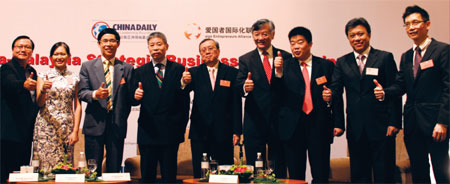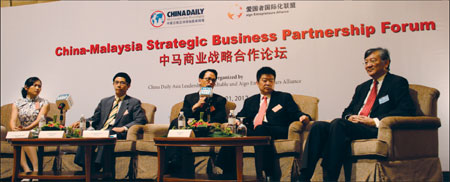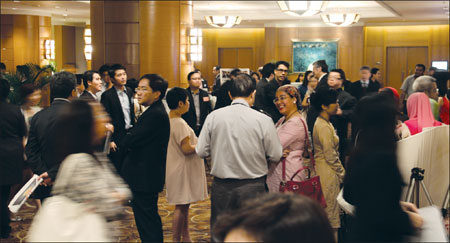A strategic partnership
Updated: 2012-09-25 06:59
By Sudeshna Sarkar in Kuala Lumpur(HK Edition)
|
|||||||||
|
Panelists and VIP guests attend the China-Malaysia Strategic Business Partnership Forum in Kuala Lumpur on Sept 21. Photos by Kenrick Lee / China Daily |
|
(From left) Zhang Lingzhi, HR director of Asia Pacific Region at ZTE Corp; Zheng Jingbo, president of Bank of China (Malaysia) Bhd; Alexander Wan, senior adviser of China Daily Asia Pacific; Feng Jun, chairman & president of Aigo Digital Technology Co Ltd; and Ng Lip Yong, former deputy minister, Ministry of International Trade and Industry Malaysia, exchange views at the forum. |
|
P. M. Lal, a guest at the forum, raises a question for the panelists. |

As the Association of Southeast Asian Nations (ASEAN) plan regional economic integration by 2015 and form the ASEAN Economic Community, investors, companies and officials from China and Malaysia came together at the China-Malaysia Strategic Business Partnership Forum to discuss economic cooperation.
The event was hosted by China Daily and Aigo Entrepreneurs' Alliance (AEA) in Kuala Lumpur on Friday. China Daily Asia Leadership Roundtable is a by-invitation network providing platforms for focused dialogue, issue investigation, and possible collective action on strategic issues relating to economic, business and social development in Asia. Aiming to enhance communication and mutual understanding between China, other Asian countries and Western countries, it is supported by the Asia News Network, an alliance of 21 leading newspapers from 19 Asian countries and regions.
"We hope (the forum and AEA) will become a bridge so that we (Malaysia and China) can work with greater scope," said Tan Chee Chai, director at Malaysian Investment Development Authority's Metal and Fabrications Industries division, in his welcome address at the forum.
"We aim to become a high-income country by 2020."
In 2010, Malaysian Prime Minister Najib Razak announced the blueprint for the nation's comprehensive economic transformation as part of the 10th Malaysia Plan. As per the vision, by 2020 Malaysia aims to reach an annual gross national income (GNI) per capita of $15,000 and above.
Malaysia's current GNI per capita is $9,700. To achieve the envisioned high-income status by 2020, it requires GNI to grow at an annual rate of six percent.
While domestic consumption will be a key driver for this growth, estimated to account for 59 percent of gross domestic product (GDP) by 2020, compared to the current 54 percent, the government hopes to boost the services and manufacturing sectors as well as revolutionize agriculture through high technologies.
As a result of this growth, come 2020, Malaysia will also become a more urban ized country. The number of people living in urban areas will increase from 64 percent of the population to 70 percent.
For all this, the nation needs greater funding, especially in infrastructure and high technology.
"The trade treaty between ASEAN and China has improved regional trade with China," Tan says. "In 2011, China was Malaysia's largest trading partner, largest export destination and largest source of imports."
The free trade agreement between China and ASEAN came into effect in 2010, creating the third-largest free trade area in the world after the European Union and the North American Free Trade Area.
In 2011, ASEAN ousted Japan to become China's third-largest trading partner with bilateral trade amounting to $362.3 billion, up 24 percent the previous year.
"Malaysia was China's eighth largest trade partner in 2011, the eighth largest source of imports and 18th largest export destination," Tan adds.
Bilateral trade in the first five months of 2012 rose 12.59 percent over the same period last year to touch $24.71 billion. So far, 31 agreements have been signed between the two governments.
The two countries are also working together on the Malaysia-China Qinzhou Industrial Park and the Malaysia-China Kuantan Industrial Park. Malaysia participates in the China-ASEAN Expo and was the country of honor at the 8th expo in 2011. Over 100 Malaysian companies are said to have registered to participate in the 9th fair being held in Nanning from Sept 21-25.
However, despite the encouraging trends, mutual investments between the two countries have not reached their full potential.
Going by investment, between 1980 and June 2012, the Chinese mainland was ranked 14th with an investment of $1.8 billion in Malaysia. It was far outpaced by Japan, the biggest investor with over 3,000 projects worth $27.4 billion, and the US, a close second with investments worth $24.9 billion.
The largest Chinese investment in Malayia is in basic metal products, accounting for over $133 million and providing jobs to more than 1,800 people.
Malaysian investment in the Chinese mainland between 2008 and March 2012 was only $725.4 million.
The welcome address was followed by a panel discussion moderated by Alexander Wan, senior advisor, China Daily Asia Pacific.
Feng Jun, chairman and president of IT enterprise Aigo Digital Technology, described during the panel discussion how he had led nearly 40 people on a four-nation tour in the ASEAN looking for investment opportunities in the region.
"We toured four countries intensively in eight days. No sightseeing, no shopping, only business, business and business," Feng said.
The AEA is a grouping that chooses only one industry from one sector to prevent infighting and was established to encourage Chinese companies to go abroad, invest and become global brands.
"Out of the 10 ASEAN countries, we shortlisted four, Thailand, Indonesia, Singapore and Malaysia, to explore which would be the best place for us to invest," Feng said.
"Each of the four has its advantage: Thailand is Buddhist and Chinese Buddhists find an affinity there. Indonesia is the biggest country in ASEAN while Singapore is one of the most modern nations with the best services industry in the region.
"In Malaysia, we have rich resources, reasonable costs and a very friendly people."
Before the forum started, Audrey Lin from the marketing and corporate communications division of Sabah Economic Development and Investment Authority, made a presentation for AEA delegates..
"We have identified sectors where we would like investment," Lin said.
Sabah, the easternmost state of Malaysia, is seeking investment in tourism, logistics, agriculture, manufacturing, oil and gas, education and palm oil.
"Chinese companies are welcome to form joint venture companies," Lin told the delegation. "Investors are showing interest and a few have come to get more information."
Her presentation highlighted Sabah's advantages. Its capital Kota Kinabalu has an international airport, Sabah is an ideal gateway for regional trade, positioned for effective transhipment and value-addition for cargo between Kalimantan in Indonesia, the South Philippines and North Asia - China, Japan and South Korea.
It also offers high value-add downstream activities such as oleochemicals, gas processing plants, oil refineries and wood-based products.
Lin's presentation was made in both English and Chinese.
Tan emphasized the natural close tie between Malaysians and Chinese.
People of Chinese descent are one of the largest groups in Malaysia, along with Malays and people of Indian origin. Many of them retain strong links with China and a large number of people in Malaysia speak Mandarin and Chinese dialects besides English and Malay.
"I speak Mandarin, Cantonese and Hokkien," Tan said. "I have Chinese relatives living on the Chinese mainland. We are very versatile and have so much variety.
"Also, we were the first in ASEAN to set up diplomatic relations with China."
China's outbound investment has been mostly in Australia and Canada by State-owned enterprises, and in Africa and South America by the private sector. African investment especially soared almost tenfold in 2011.
However, in the days to come, the carbon tax and mineral resources rent tax slapped by Australia from July is bound to impact foreign investment. The sluggish economy has made Canada make low investment returns while in Africa investors face instability and security issues.
So with Malaysia's 2020 high-income plan on the anvil and with the Chinese government's "Going Global" policy encouraging investors to diversify overseas, people in both countries are optimistic of significant developments in the days ahead.
Zheng Jingbo, president of the Bank of China (Malaysia), is one of them.
"Because of our cultural relationship, we can build up a strong economic relationship," Zheng said during the panel discussion.
The bank first set up shop in Malaysia in 1939.
"It had five branches, including one in the capital," said Zheng. "However, it moved to Singapore (in March 1959) due to changes. (In February 2001), the bank returned, with the support of the governments of both countries."
With a capital of $80 million and six branches, Bank of China (Malaysia) plays a key role in meeting the financial requirements of overseas Chinese, like sending remittances. However, locals too form a major part of its clientele. Also, over 90 percent of its nearly 200 employees are locals.
Bank of China (Malaysia) is playing a role in bringing Chinese investors to Malaysia, providing advice and facilitating entries. One such major investor is Beijing Capital Steel which has a project in the Malaysian port city Kuantan, capital of Pahang state.
Its other important role is acting as a clearing bank for yuan transactions and contributing to the effort to establish the Chinese currency as an international currency.
According to a statement by the bank, 11 Malaysian financial institutions, including major banks in the country, signed up for the renminbi settlement service this year. The signing came after Bank Negara, the central bank of Malaysia, said the renminbi settlement service be included in its real-time electronic transfer of funds and settlement system.
The central bank said the move would provide "a natural hedge against the fluctuations and volatility of other currencies" and reduce settlement risks for yuan transactions.
Bank of China (Malaysia) was appointed the onshore settlement institution of the renminbi settlement services.
"For greater economic relationship, we need more favorable economic policies and stability," said Zheng. "Also, it is important to have a good mutual understanding.
"More and more Chinese are investing abroad. They and (their Malaysian counterparts) can know each other better through us."
The forum was also attended by Xuan Guoxing, counselor, Economic and Commercial Counselor's Office, Chinese embassy in Malaysia, Lindsay Zhang Lingzhi, human resources director, Asia Pacific region of ZTE Corporation, Lee Koh Yung, National Council member, Malaysia-China Chamber of Commerce, Wong Chun Wai, executive director and group chief editor, Star Publications, and Tan Kim Chuan, general manager, corporate communications and promotion, Sin Chew Daily.
sarkar@chinadailyapac.com
|
Participants chat before the forum starts. |
(HK Edition 09/25/2012 page2)



